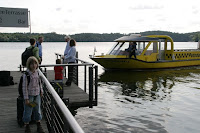This afternoon we (over 40 people from VIS and VISUS at the University of Stuttgart) went to Karlsruhe to visit the ZKM. We got guided tours to the panorama laboratory, the historic video laboratory, to the SoundARt exhibition and some parts of the regular exhibition. Additionally Prof. Gunzenhäuser gave a short introduction to the Zuse Z22 that is in on show there, too.
The ZKM is a leading center for digital and media art that includes a museum for media art and modern art, several research institutes, and an art and design school. The approach is to bring media artists, works of art, research in media art and teaching in this field close together (within a single large building). The exhibitions include major media art works from the last 40 years.
The panorama laboratory is a 360 degree (minus a door) projection. Even though the resolution of the powerwall at VISUS [1] is higher and the presentation is in 3D, the360 degree 10 Megapixel panorama screen results in an exciting immersion. Without 3D, being surrounded by media creates a feeling of being in the middle of something that happens around you. Vivien described the sensation of movement similar to sitting in a train. The moment another train pulls out of the station you have a hard time to tell who is moving. I think such immersive environment could become very common once we will have digital display wallpaper.
The historic video laboratory is concerned with “rescuing” old artistic video material. We sometimes complain about the variety of video codecs, but looking at the many different formats for tapes and cassettes, this problem has a long tradition. Looking at historic split screen videos that were created using analog technologies one appreciates the virtues of digital video editing… Two are two amazing films by Zbigniew Rybczyński: Nowa Książka (New Book): http://www.youtube.com/watch?v=46Kt0HmXfr4 and and Tango: http://vodpod.com/watch/3791700-zbigniew-rybczynski-tango-1983
The current SoundArt exhibition is worthwhile. There are several indoor and outdoor installations on sounds. In the yard there is a monument built of speakers (in analogy to the oracle of Delphi) that you can call from anywhere (+49 721 81001818) and get 3 minutes of time to talk to whom even is in the vicinity of the installation. Another exhibit sonfied electron magnetic fields from different environments in an installation called the cloud.
[1] Powerwall at VISUS at the Univeristy of Stuttgart (6m by 2.20, 88 million pixel in, 44 million pixel per eye for 3D). http://www.visus.uni-stuttgart.de/institut/visualisierungslabor/technischer-aufbau.html.








